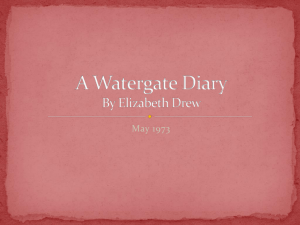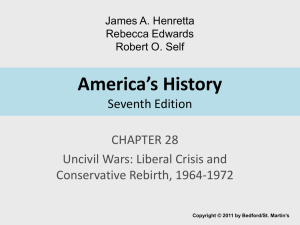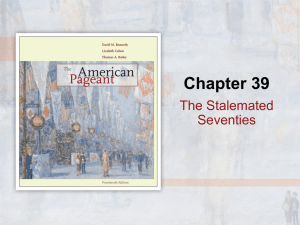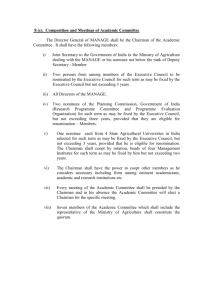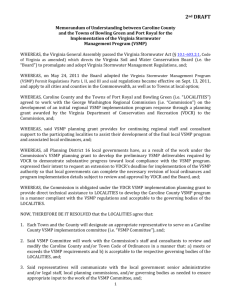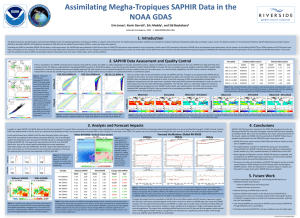RRBC Minutes 9-18-13
advertisement
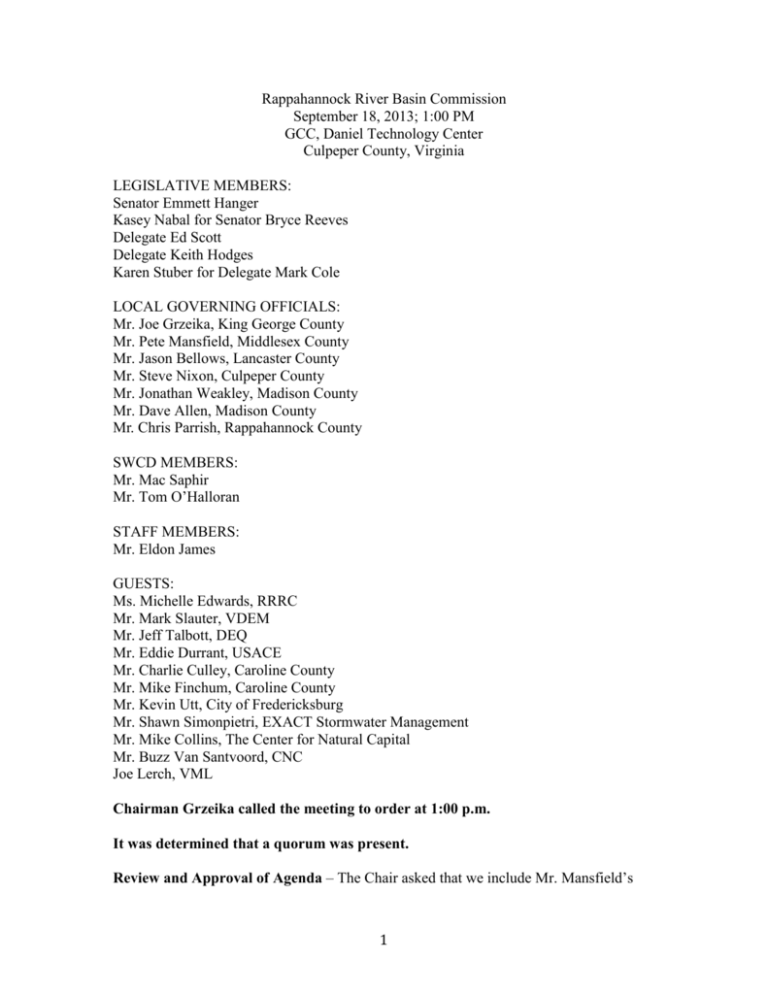
Rappahannock River Basin Commission September 18, 2013; 1:00 PM GCC, Daniel Technology Center Culpeper County, Virginia LEGISLATIVE MEMBERS: Senator Emmett Hanger Kasey Nabal for Senator Bryce Reeves Delegate Ed Scott Delegate Keith Hodges Karen Stuber for Delegate Mark Cole LOCAL GOVERNING OFFICIALS: Mr. Joe Grzeika, King George County Mr. Pete Mansfield, Middlesex County Mr. Jason Bellows, Lancaster County Mr. Steve Nixon, Culpeper County Mr. Jonathan Weakley, Madison County Mr. Dave Allen, Madison County Mr. Chris Parrish, Rappahannock County SWCD MEMBERS: Mr. Mac Saphir Mr. Tom O’Halloran STAFF MEMBERS: Mr. Eldon James GUESTS: Ms. Michelle Edwards, RRRC Mr. Mark Slauter, VDEM Mr. Jeff Talbott, DEQ Mr. Eddie Durrant, USACE Mr. Charlie Culley, Caroline County Mr. Mike Finchum, Caroline County Mr. Kevin Utt, City of Fredericksburg Mr. Shawn Simonpietri, EXACT Stormwater Management Mr. Mike Collins, The Center for Natural Capital Mr. Buzz Van Santvoord, CNC Joe Lerch, VML Chairman Grzeika called the meeting to order at 1:00 p.m. It was determined that a quorum was present. Review and Approval of Agenda – The Chair asked that we include Mr. Mansfield’s 1 discussion item from Middlesex County as a new #9 on the agenda. Mr. Nixon made a motion to approve the agenda as revised and Mr. Saphir seconded. The motion was approved unanimously by the Commission. Adoption of Minutes from June 12, 2013 Meeting Mr. James confirmed that Tom O’Halloran was also present at the last meeting and that he needed to be added to the June minutes. Mr. Saphir made a motion to accept the minutes with the one correction, the motion was seconded by Mr. Nixon. The Motion carried with Mr. Thomas abstaining. Public Comment - No comment at this time. Presentation of the next Steps recommendations to implement the Rappahannock Rainfall Stream and Water Quality Gauge Analysis - Mark Slauter, VDEM and Staff. Mr. James reviewed the history and the timeline of the project. Mr. Slauter reviewed the public safety importance of improving the stream and rain gauges in the middle and upper basin. He said the Commission had previously said that it be important to be able to add water quality gauges when resources allow. Mr. Slauter reviewed the recommended sites around the upper Rappahannock basin. He said currently there is no monitoring in a large part of the basin. He reviewed the location of current and proposed sites. Mr. Slauter reminded the Commission that the proposed gauges would feed information to VDEMs iFlows system and its statewide support of public safety preparedness and response. Mr. Slauter explained that VDEM has a contractor that currently maintains approximately 280 locations. He has discussed with the contractor the details of adding these gauges to the contract. Mr. Slauter explained how the units communicate using radio frequencies and of line of site. He explained how each site will have to be analyized to optimize reception. He said at this point the estimated total cost for the project is $177,000. He said they are hopeful we can move this forward as a partnership. Mr. James reviewed from the previous discussion at the June Commission meeting when the Technical Committee recommended proceeding with the top priority stream and rainfall gauges with the potential to add water quality gauges in the future. The question for the Commission is whether to proceed with a the request that funding be provided to develop the top 14 sites. He said the members on the Technical Committee have indicated from a public safety standpoint it makes sense, and with state and local funding when divided up it is a relatively small commitment. Mr. James stated that as Mr. Slauter has indicated that VDEM may be able to fund a small portion of the project in its current budget. Mr. James asked what is a reasonable cost sharing agreement between the Commonwealth and Stafford, Spotsylvania, Fredericksburg, Culpeper, Orange, Fauquier and Rappahannock. There was some discussion on this. Mr. Nixon asked how typically the management of the sites work. Mr.Slauter reviewed this for the Commission. There was a question on ongoing maintenance and operation costs. Mr. Slauter said they have approximately 280 gauges and the annual budget is $225,000 so they are looking at 2 an increase of less than $1,000 per site for a O&M cost. He also noted because they already have the contractor they can add these sites into the existing contract. Delegate Scott suggested when a request like this comes before the General Assembly it would important to show the cost is being shared. There was considerable discussion of how cost sharing might work and a question was raised that we be certain that the gauges can adequately be upgraded to add water quality monitoring in the future. Mr. Thomas said from Stafford County he would like to see the information get out. There was a question concerning federal money available for the project and it was clarified that there is no federal funding available at this time. Chairman Grzeika said if the Commission wants to move this forward we need to go to the localities and ask for their letters of support so when the General Assembly meets they have the support they need. Mr. Saphir asked if Mr. Slauter could clarify how much VDEM can contribute to the project and answer the future water quality monitoring question. Mr. Nixon made a motion to proceed on the Chairman’s recommendations after we receive additional information from VDEM, Mr.Saphir seconded the motion. The motion passed unimamously. VDEM will provide additional information at the December meeting. Update on Potential Next Steps to the Basin-wide Water Resource Planning Opportunities to Integrate TMDLs into a Comprehensive Water Resources Plan for the Rappahannock Basin - Staff, and Eddie DuRant, Chief, Planning Resources Section USACE, Norfolk District Chairman Grzeika said they are looking at this from an ecological and a water quality standpoint and he said they have had a number of discussions in person and on the phone and lot of time has been spent to get to define the potential project. Mr. James said the Commission asked that they work with Mr. DuRant and other USACE staff to develop this scope of work being distributed and he is going to talk about the process that several Commission members and Technical Advisory Group have worked with the Corp to put this together. The Corps is precluded from making water quality the primary focus of their planning projects but they can focus on ecosystem restoration including oyster and stream bank restoration efforts which can positively impact water quality. Mr. DuRant read a note from Mr. Darrow who will not be here because he is deploying to Afghanistan. He said he wanted to reiterate the scope of work sent to the Commission members. Two weeks ago they had a phone call with an ad hoc group of Commission and Technical Committee members. Mr. DuRant said he wanted to jump into the document on page 8 of the proposal at the top in italics is the U. S. Senate resolution of environmental and public works. He reviewed the federal authority to move forward with the feasibility study for the Rappahannock. He said a comment that always comes up is that water quality is a huge concern for Commission members for the watershed and as the Corps planning policy is that they cannot have a primary driver of water quality but they can approve a plan to include that as a part of the overall plan. He reviewed that the first few pages and the SMART plan to allow them to move through the planning process a little quicker. He said they have to follow a 3x3x3 rule with the headquarters driving to complete studies within three years, within $3 million and 3 levels of integration 3 involving headquarters and division folks. He said they are going to look into an inventory of environmental restoration opportunities that can be used as a tool or a product that can be delivered to the Commission. He said under the environmental feasibility study they would look at all the opportunities within their scope of defined work. He said the primary deliverable from the USACE is the feasibility study itself and within the Smart Plan so they can seek appropriations for future capital projects identified in the plan. He said they would develop a project management plan that uses considerable input including charettes to identify any problems and any opportunities for ecosystem restoration. They examine alternative approaches to each project identified. The last thing in the deliverables is an environmental restoration inventory database that is usable by each locality. He said this gives an opportunity to put together a tool to rank projects on multiple criteria including impacts on water quality and the WIPS. Mr. Saphir asked who would provide the $1.5 million non-federal funds? Mr. DuRant said they are looking to the Commonwealth and the localities of the basin. Mr. Saphir asked if the federal portion is already appropriated. Mr. DuRant said they do already have some of the money. Mr. DuRant was asked about oyster restoration and he confirmed that it would be one of the projects examined. Mr. James asked as an example if the Corps would ultimately participate in such a capital project. Mr. DuRant said it could be 50/50 or 40/60. A discussion ensued of the types of projects that could be included. Chairman Grzeika summarized some of the concerns about investing considerable state and local dollars into a planning project versus into actual improvements on the ground. Is the information gained going to be valuable enough in determining how to optimize investments. Delegate Scott said he thinks there is some benefit by the answers that would be developed, but that the 50% match coming from the state may be a tough sell. If we go to Richmond to get the match when there are other things, point and non point source, that we can do to allocate the money to get an improvement tomorrow. Chairman Grzeika said we struggle with this because we need something with impact. Mr. Nixon said his specific concern is that he would rather take the money and put it into something with a direct benefit, as opposed to putting the money in something that will not make a direct benefit. Mr. Mansfield said we know where out biggest problem is and if we focus our resources on correcting the biggest problem we will be ahead. Chairman Grzeika said if we spend $1.5 million on limited resources it is $1.5 million we won’t have to use for something else. Mr. O'Halloran said there is a tremendous need and that there are enough identified local projects that need to be done. He added that each one of the projects done in Culpepper has made a huge difference in the water quality down stream. Senator Hanger said the point Mr. James has made about the feasibility study giving us potential access to federal funds for key projects is a valid one. There was some discussion on how this can be done to present a clear picture to the General Assembly. Mr. Nixon said let’s say we identify 15 projects and we decide to take one at a time, and we come to the table, will the Corps say they will participate. Mr. DuRant said if the projects are identified in the plan that they can participate in, it will happen. He said his concept is to identify projects to be 4 included in the final study database and using the costs and benefits prioritize those projects. Mr. Nixon said he does not want to see the Corps help with a few of the projects and the other projects are left up to the localities. Mr. James said this is an opportunity to hear the Commissions concerns. He said if the non-federal project costs are split 50/50 between the Commonwealth and the localities and it is spread over three budget years it would be between $16-17,000 per year per locality. He said we are also assuming that once it is scoped out it comes out to the maximum of $3 million. Chairman Grzeika said going to the General Assembly without more specifics in the proposal is not going to work. Senator Hanger said this is a good discussion but there needs to be more information on the outputs and the assessment. Mr. DuRant said they would need some feedback from the Commission on what their deliverable should be. Chairman Grzeika pointed out some of the criteria that needs to be included in the proposal to make it complete and ready to ask the General Assembly for the money. Mr. James said feasibility is the last step before moving to capital projects. It is our basis for project appropriation and funding. There was some more discussion on the breakdown of the funding and Mr. Nixon said it might be prudent to bring out in the final proposal to explain that the Corps can provide a percentage of the funding. The Corps staff and RRBC staff will continue to discuss how to refine the scope. Work Session - RRBC Technical Committee Recommendations of Potential Legislative Actions to improve the Effectiveness and Efficiency of Implementation of the Virginia Stormwater Management Program Mr. James discussed the papers in the packets including the presentation on what’s ahead with local stormwater. The second item is a concise two and half page summary of the Technical Committee’s recommendations after they have spent a number of months looking at the VSMP program. He then presented the five recommendations: 1) For localities outside of the current Chesapeake Bay Act area (Rappahannock, Madison, Orange, Culpeper and Fauquier counties) when a land disturbing activity occurs on a single family lot that is not part of a Common Plan of Development (subdivision) the owner or builder must submit an engineered stormwater management plan if the land disturbance is greater than 1 acre. This engineering will be an added cost for the homeowner. Currently for Erosion and Sediment Control (E&S) the owner or builder of a single-family home can sign an “agreement in lieu of a plan.” The Technical Committee recommends that the Commission ask DEQ to develop an alternative to the fully engineered plan for those single-family lot situations in the upper basin similar in concept to what is already allowed for an E&S agreement in lieu of a plan. 2) Currently the VSMP statute calls for “formal” hearings to resolve disputes. A formal hearing is an intensive, trial-like proceeding including advance depositions of witness, issuance of subpoenas to compel witness attendance and production of documents, a verbatim record, payment of witness fees and mileage expenses, etc. In contrast, the E&S program has operated successfully for decades using informal hearings, where affected parties have a full opportunity to be heard but without the delay and expense of trial-like formal hearings. With either approach, final decisions are subject to review by the Circuit Court, which is further 5 assurance of due process. Since a goal of the 2012 “Integration Bill” was to integrate the various water quality programs – but these similar, related regulatory programs (VSMP and E&S) have different hearing procedures – the Technical Committee recommends that the VSMP hearing procedures be conformed to the time-tested E&S procedures familiar in the Commonwealth. 3) For all lots within a Common Plan of Development the developer should be required to obtain and maintain the VSMP permit coverage and maintain all required documents, records and reports. This will be more efficient than having each individual builder have separate permits and associated records for each lot. 4) If the proposed regulations for VTAP (the Virginia BMP clearinghouse) are adopted Virginia will have the most rigorous and expensive certification process in the country for accepting proprietary BMPs. For the past ten years Virginia has had reciprocity with other states that have certification programs. Under the current VTAP proposed regulations Virginia would no longer recognize the approvals of other states. The Technical Committee recommends that legislation be introduced to require Virginia to continue the long-standing reciprocity recognition of certification programs of other states. 5) Remove the requirement from the Construction General Permit that permitees must comply with Virginia’s post construction standards for water quality. This permit is for construction and terminates when construction is complete. The requirement is redundant, as post construction water quality must be assured under the VSMP regulations. Additionally, many local governments with existing stormwater programs already review post-construction designs in the site-plan review process. Concerning recommendation #3 Delegate Scott asked how can the responsibility remain after a Developer sells the right to development of property. Mr. Nixon acknowledged that under the current way permits could work, for a 100-lot subdivision work you may have 100 different permit applications which is not efficient but the Developer cannot be responsible forever. Mr. Utt said as the process now stands you sell off the lots each one has to pull their own permit and it is a burden to the localities and individual builders. Mr. Nixon said the hybrid would be if it is under a general permit can this work. It was suggested that the Developer be responsible for the initial permit coverage for the subdivision and that when he transfers the final lots to the last builders then DEQ allow for an efficient manner to transfer permit coverage as opposed to separate Stormwater permits on each individual lot. Concerning recommendation #4 there was some discussion on how the Virginia testing program would work. Chairman Grzeika said he is concerned that in recognizing other programs they are credible and this is to ensure that EPA does give us credit for this. Mr. Sean Simonpietri said putting it into a nutshell the cost in Virginia will be extensive to approve a BMP and there are not that many manufactures that will spend that much money to get approved in the state. Virginia has recognized the work in other states for 6 the past decade and we should continue that practice. Mr. James added that the Committee did not have a recommendation for the fees but they did want to point out that there are concerns about the fee structure imbedded in the regulations. He added that although no specific alternative is being recommended by the Committee it was pointed out that the Commonwealth oversees, reviews and audits other local programs such as E&S, Chesapeake Bay and National Flood Insurance without assessing fees. A review of the Commonwealth’s cost to administer the program may be in order. Discussion ensued on several of the recommendations. Mr. Weakley moved to approve the five recommendations of the Committee with the amendment of #3 to reflect the appropriate transition of the permit from the Developer when he sells out of the subdivision and adding a sixth recommendation to review the fee schedule. Mr. Mansfield seconded the motion. During the discussion of the motion Mr. James said he would work with Mr. Nixon clean up the language in #3 and work with the Chair to draft a letter to DEQ. The motion passed unanimously. Senator Hanger said DEQ has been working with them to hold a series of meetings around the state focusing on the roll of the SWCDs and their relationship with DCR and DEQ. The first is Oct. 1 in Augusta County and one of the last ones is in Culpeper. Mr. Saphir said they have sent the information for the meetings out and they are trying to disseminate the information on the public meetings. Center for Natural Capital Projects Update - Mike Collins, Center for Natural Capital Mr. Collins stated that they are a 501(c)3 organization that began in 2006 right about the time the Commission began a discovery process on market-based conservation. The notion that the potential source of our problems with the environment is how we structure our economy and commerce. The Center’s mission is economic development through ecosystem health, jobs through environmental restoration and jobs through conservation. They have four programs energy, rivers, landscape and people. The work they do is not about regulation it is purely voluntary. He said in terms of a dovetail we are not saying you need more regulation you need synergy between the public and the private sector. Mr. Collins discussed the Rivanna River Forests to Faucets a payments program for watershed services for rural landowners by optimizing gray and green infrastructure to get the least cost for sedimentation, to Charlottesville. One of their companies is ahyayha which focuses on natural capital finance. One of its projects was Rapidan stream sweepers where we pay college students for river cleanup projects. Another project is a river monitoring projet in the Valley, also carried out by students. The Rivanna Forests to Faucets is a capital improvement process to link urban and rural consumers with a capital improvement project. He discussed how they are in the fourth year of the project and entering into phase 2 and developed a water payment system for upstream sediment reduction services. It looks to optimize three practices tree planting, dredging and forest easements. He also discussed the summary results for the project 7 with rural landowners would accept voluntary payments for practices with a blended cost of 25/acre, purchased service on 800 acres. They found that grey infrastructure cost effectiveness is $15/ton and green infrastructure cost effectiveness is $4/ton. He said they also found that there has to be a minimum 30-year CIP horizon. The next project is crowd funding for conservation with project basics of providing ecommerce grants to project leaders of $1k -10k and they also get incentives. He discussed some of the projects funded through a common platform where they shared common concerns about the world. Every contributor to the project gets a nitrogen offset certificate. Mr. Collins discussed the results from one year of the projects. Concerning the theme of jobs through river cleanup he discussed some of the downsides of typical cleanup projects – they tend to sporadic and do not have the resources to get large objects out of the river. Using two realities - college students need jobs and the landowners take pride in their river front property, they created a river restoration job corp. He said they submitted a proposal to the EPA and NFWF that was declined because they said it would never work. The project basics: select river reach, give jobs to college students, and provide information and services to landowners. They “sell” cleaning and diagnostic services to landowners and watershed supporters. They had four young adults with seven miles of river at 10 cents a foot to rid the river section of trash including tires, cans, oil drums, etc.. It was funded by a support group and a philantrophic group. The total cost with 7 people employed for the summer was $15,000. All funds were raised privately and the clean up and assessment were as a success by all contributors. They are starting to work on plans to expand the program next summer. Fredericksburg Brownfield Grant Program Accomplishments - Kevin Utt, Site Development Manager, City of Fredericksburg In 2009 the City applied for a grant with letters of support from the community. Mr. Utt said the City staff has learned a lot in understanding Brownfield sites and how to manage them for the benefit of the community. He explained that Brownfields are real property, the expansion redevelopment, or reuse of which may be complicated by the presence or potential presence of a hazardous substances, pollutants or contaminants. In 2010 they received a $400,000 community assessment grant. The purpose of the grant was to assess the level and nature of selected Brownfield sites and conduct planning for the cleanup and reuse of the properties. He said that the City of Fredericksburg is located in region 3. This is not a regulatory program through the EPA, but is strictly a voluntary program. He discussed the history of the program since its inception in 1995 and why it was designed. He said there is estimated over 450,000 sites in the country. Mr. Utt reported that he has an MOU that constitutes no federal interest in the cleanup and it says EPA will not come after you if you fail to cleanup if you voluntarily participate in the assessment. He reviewed the benefits to the property owners. He added that the liability exists whether the contamination is known or unknown. Mr. Saphir asked what if they find something really hazardous and what is the contingency plan for that. Mr. Utt said his funds only provide for an assessment and a plan, it is up to the property owner to do something with the information. It is voluntary to the property owner and they can seek financial assistance to help remediate the problem. The EPAs vision of the program is to help cleanup the property and not fine the property owners. There was some discussion on having knowledge of the environmental risk at that point becomes more of an assessment 8 does it become a liability for the property owner if there is a risk to other properties. Other - Mr. Mansfield said Middlesex County passed a resolution expressing concern about the threat to the Potomac Aquifer due to overdrawing water for potable and nonpotable uses. The resolutions encourages the investment of funds to redirect wastewater discharges to nonpotable reuse such as the prepare mill at West Point. He distributed a copy of the resolution and background information. After some discussion he expressed hope that the Commission could consider a similar resolution at a future meeting. He added his hope convince the General Assembly to invest funds because it will be returned to them in the future through nutrient pollution reduction and preserving our potable water source in Eastern Virginia. Financial Report - Mr. James distributed the standard financial report. He said we are where we would expect to be this time of the year with the finances and asked if there are any questions to contact him. On a motion by Mr. Allen, seconded by Mr. Mansfield the financial report was accepted. He added that when budgets had to tighten a few years the Commission made a decision to not reimburse the members for mileage. He said he felt this was something that could now be resumed and unless there is an objection we would resume the previous policy. He suggested that it is voluntary and to send him an email. Status Update on RRBC FY13 Work Plan - Staff Mr. James reviewed the status of the work plan and said if anyone has any questions to contact him. Future Meeting Dates and Future Agenda Items: December 4, 2013 - Richmond March 26, 2014 - Middle Basin June 18, 2014 - Lower Basin September 17, 2014 - Upper Basin Identification of Potential Agenda Items for the December 4, 2013 RRBC meeting: Scott Kudlas with DEQ to provide an update on DEQ’s water supply planning and regulatory program; Follow up on the gauging proposal; Follow up of stormwater from discussion today; Other potential legislative items; Chairman Grzeika said it is important to give more exposure to the successful voluntary projects; Chairman Grzeika said he would like to commend Mr. Utt for his project and how they are starting to see some of the efforts on the ground and through the efforts of what we see here we are starting to see some improvements. 9 Mr. James said he appreciates the Commission’s discussion and comments on the Technical Committee’s stormwater management program work. He said there was a tremendous support from Technical Committee members and how they got a lot of valuable input and that he appreciates the Commission recognizing their work. The meeting adjourned at 4:00. 10
